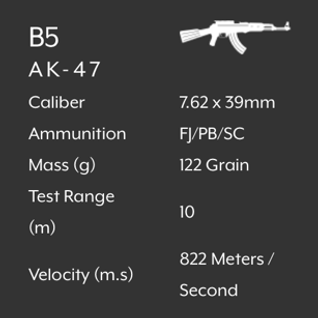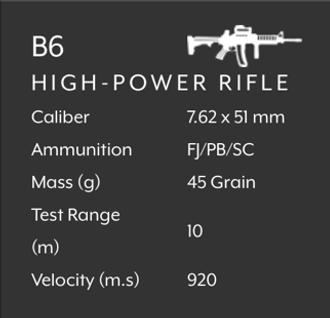
Vehicle Armoring Technolgies
Robust, Reliable, and Modular
Our Process
Ballistic Protection Levels

Protection Standard | B4 Level
The B4 rating is part of a range of protection levels typically used to classify the armor on civilian and military vehicles, and it is based on the level of resistance the armor provides against various types of ammunition.
-
B4 armor is designed to protect against small arms fire and some light ballistic threats.
-
B4 Protection is typically rated to stop rounds fired from handguns, submachine guns, and assault rifles.
-
Specifically, B4 level armor is effective against up to 7.62x39mm ammunition, which is the standard round for rifles like the AK-47, and can protect against mildly armored projectiles.
Common Threats Stopped by B4 Armor
-
7.62x39mm (AK-47 and similar calibers)
-
5.56x45mm (M16 and similar rifles)
-
Handgun rounds such as 9mm, .44 Magnum
The armor is typically made of materials like steel, composite plates, or ballistic fiberglass, designed to absorb and dissipate the energy of the incoming rounds. This level of protection is often found in civilian armored cars, law enforcement vehicles, and some light military vehicles.

Protection Standard | B5 Level
In the context of B5-level armor, this generally means the vehicle is designed to offer protection against high-velocity handgun ammunition and some light rifle rounds. Specifically, a B5-level vehicle can typically withstand threats such as:
-
Handgun ammunition: Up to a .44 Magnum or similar caliber, which is a powerful handgun round.
-
Light rifle ammunition: Protection against rounds like 5.56x45mm NATO or 7.62x39mm (the latter is commonly used in AK-47-style rifles).
The armor at the B5 level can be made from materials like ballistic steel, ceramic, or composite materials, depending on the vehicle's design and purpose. These vehicles are typically used by law enforcement, high-profile individuals (VIPs), and in areas where there are higher risks of gunfire or civil unrest, but they are not typically capable of withstanding more powerful weapons like military-grade rifles or explosives (those threats would require higher levels of armor, such as B6 or B7).

Protection Standard | B6 Level
In this classification, B6 indicates a vehicle is designed to withstand:
-
Protection against 7.62×51mm NATO ball ammunition (typically fire) from assault rifles like the FN FAL or HK G3).
-
It is resistant to small arms fire, including high-powered rifles, but not to armor-piercing ammunition or high caliber rounds.
In addition to ballistic protection, the B6 rating typically includes resistance to threats such as fragmentation from explosives, though it is not as heavily protected as higher levels (e.g., B7, B7+), which would be designed to withstand more powerful or armor-piercing rounds.
Key Features of a B6 Level Armored Vehicle
-
Ballistic Glass: Windows are made from multi-layered glass that is resistant to bullets.
-
Body Armor: The body is reinforced with steel, composite, or other armor materials that resist penetration from typical small arms fire.
-
Tires: The vehicle may also be fitted with run-flat tires that allow it to continue moving even if the tires are damaged by gunfire.
Applications
B6 armored vehicles are often used by high-profile individuals, such as politicians, diplomats, and business executives, for security in high-risk areas. They are also used by law enforcement, military, and security firms for missions that involve moderate to high levels of threat but not extreme combat environments.
It is important to note that the B6 level is considered suitable for protection against typical civilian and some military threats, but it is not sufficient against heavy military weaponry such as high-caliber machine guns, RPGs, or IEDs.

Protection Standard | B7 Level
A B7 level armored vehicle is designed to withstand more powerful ballistic threats compared to a B6 level. The B7 rating includes protection against:
-
7.62×51mm NATO armor-piercing (AP) rounds: This is a significant increase in protection compared to B6, as B7 can withstand ammunition that has been specifically designed to penetrate armored material.
-
The vehicle's armor is stronger, typically including advanced composite materials (such as aramid fibers or ceramics) and hardened steel to resist these more potent rounds.
Key Features of a B7 Armored Vehicle
-
Ballistic Glass: Windows are made from multi-layered ballistic glass, which can stop high-caliber rounds like the 7.62mm AP round.
-
Body Armor: The vehicle body is reinforced with additional layers of hardened steel, composite, or ceramic materials that can resist the penetration of armor-piercing rounds.
-
Run-flat Tires: Like B6 vehicles, B7 armored vehicles typically have run-flat tires that allow the vehicle to continue moving even if the tires are damaged or shot out.
-
Improved Underbody Protection: Some B7 vehicles may have additional protection against explosive threats, though this varies based on design and intended use.
Applications
-
High-Risk VIPs: B7 armored vehicles are used by government officials, diplomats, business executives, and other high-profile individuals who are at risk of more serious attacks.
-
Military and Law Enforcement: These vehicles are also used in conflict zones or by specialized military units that may face more significant threats, such as those involving armor-piercing projectiles.
-
Security Firms: Private security contractors may use B7 armored vehicles to protect clients in high-risk areas where larger calibers or more sophisticated weapons are expected.
Comparison to B6
The main difference between B6 and B7 armored vehicles is the level of ballistic protection:
-
B6 provides protection against standard small arms fire, including the 7.62×51mm NATO ball (standard military round).
-
B7 provides protection against more advanced threats, including armor-piercing (AP) rounds of the same caliber, which are much more difficult to defeat and capable of penetrating lighter armor.
Because of this, B7 armored vehicles are heavier, more expensive, and more difficult to manufacture, but they offer a significantly higher level of protection against advanced ballistic threats, especially in high-conflict areas.
.png)




.png)
.png)
